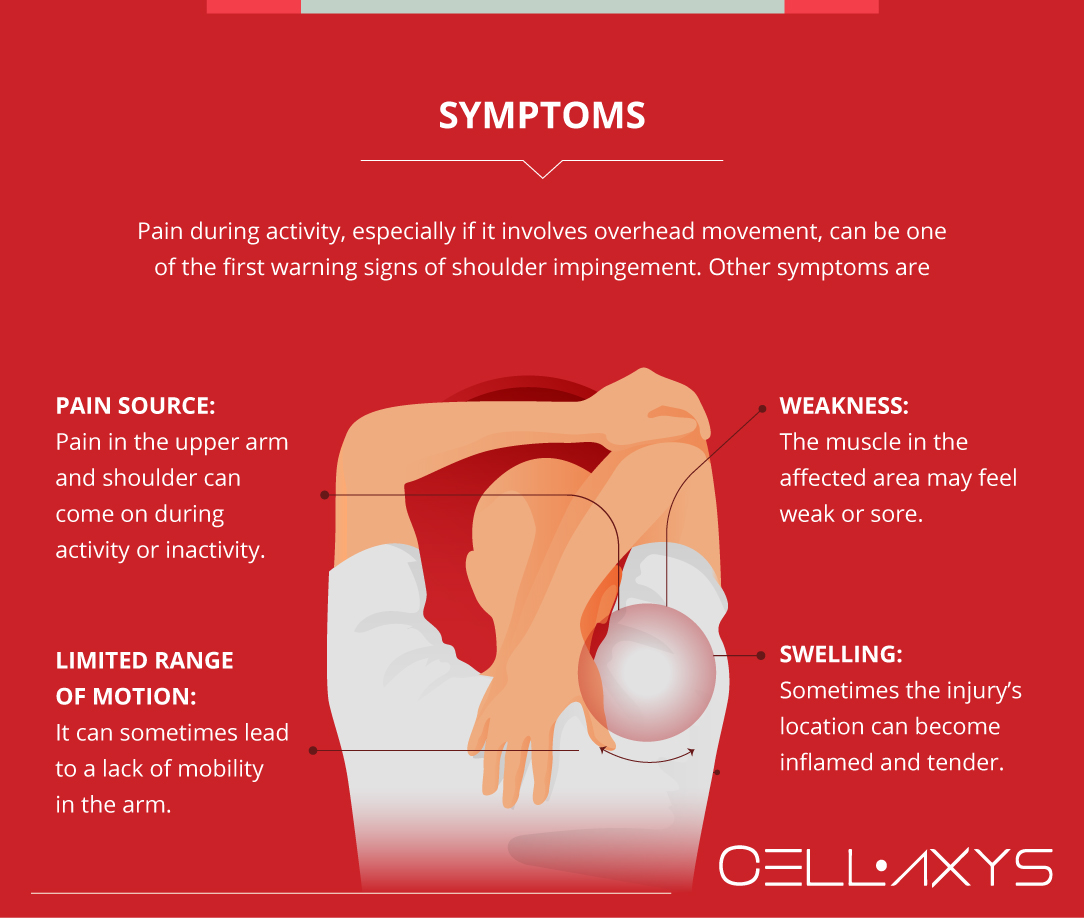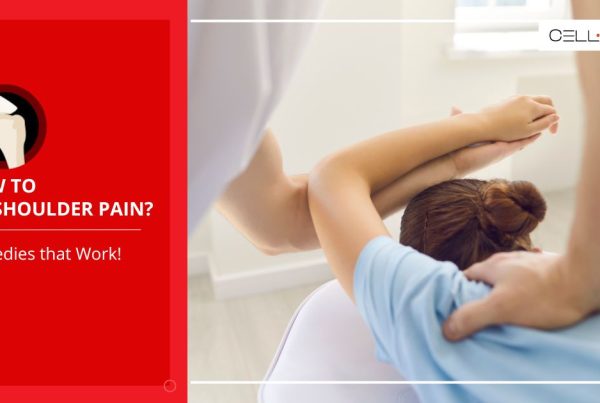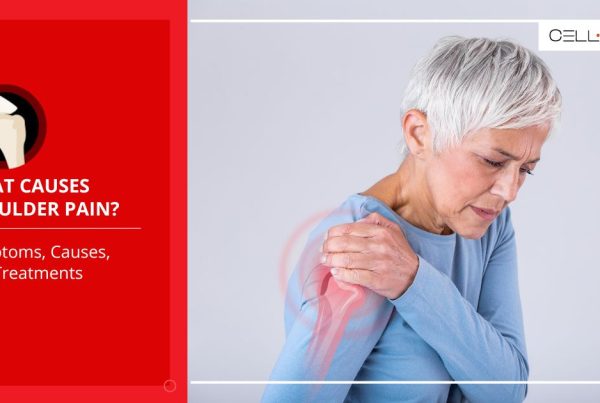Published on: August 22, 2019 | Updated on: August 29, 2024
Most sports and many day-to-day activities would not be possible without our shoulders. They work to support not only the entire arm but much of the back as well. When the shoulder becomes injured it can take a toll on our way of life.
The shoulder is comprised of many moving parts which help it achieve the fluid motion we are used to. With such an intricate network of bone, muscle, and soft tissue, certain things can go wrong.
One of the most common diagnoses for shoulder pain is shoulder impingement – this implies that the tendons and nerves in the shoulder are being pinched. This can happen for a variety of reasons, but the common denominator for most of the potential causes is the degeneration of tissue over time.
Degeneration is a natural process that the body goes through as it ages, but this natural process causes us to experience pain. Many doctors are well versed in shoulder pain and can help direct a patient toward a treatment plan, but the conventional course of treatment is not the only one. Regenerative therapies offer an alternative, and often less complicated, treatment.
Shoulder Anatomy
The shoulder contains an intricate network of bones, muscle, and soft tissue which work together harmoniously to allow for motion. There are many tissues in the shoulder and each has a specific and important role in overall shoulder health and functionality.
As far as bones, there are 3 which make up the majority of the shoulder:
- Humerus: one of the longest bones in the body, the humerus aids in all motion concerning arm movement. It is located in the upper arm.
- Scapula: the shoulder blade provides support to the arm and upper back and connects the humerus and clavicle. It is located on the backside of the body.
- Clavicle: the collar bone provides support to the arm during movement as well as structural support for the arm and ribcage. It is located at the top of the rib cage and the bottom of the neck.
A fourth bone, the acromion, is equally as important though not necessarily a part of the shoulder itself and helps determine the likelihood an individual will develop shoulder impingement. It is located above the scapula and helps to protect the ligaments and muscles that make up the shoulder joint.
The acromion can grow in 3 different formations: flat, curved, and hooked. Shoulder impingement is more likely in the curved or hooked types, as their more curved structure is likely to pinch the tendons below them.
Under the acromion, you will find the bursa and rotator cuff tendons. Bursae are fleshy sacs that exist in joints all over the body. Bursae act as a cushion between bones and the surrounding soft tissue in joints. The soft tissue which bursae aim to protect includes muscles, ligaments, and tendons.
In the shoulder joint, the bursa is located under the acromion and is meant to act as a buffer between the rotator cuff tendons and acromion. The rotator cuff tendons are used in most functions of the arm and connect at the top of the humerus.
The configuration of these bones can cause symptoms of impingement because the area called the subacromial space (between the acromion and the ball-and-socket joint) can pinch the tendons lying inside. Over time with degradation the subacromial space can become smaller which may lead to pinching as well.
Causes of Shoulder Impingement
The interconnectedness and complexity of the shoulder system mean that pain is often caused by several things simultaneously. These are some of the most common causes of shoulder impingement:
- Overuse: activities that involve frequent overhead motions such as swimming, tennis, and baseball can contribute to more rapid degeneration of the shoulder muscles and tendons. It is not only athletes who can be affected by shoulder impingement; anyone whose lifestyle involves frequent overhead motion can be susceptible.
- Previous injury: people who have sustained a shoulder injury in the past could be at risk of developing shoulder impingement.
- Osteoarthritis: arthritis is characterized by the degeneration of tissue surrounding or inside of joints. As these tissues degrade, the shape of the subacromial space changes and can lead to impingement.
- Bone structure: patients with acromion that are hooked or curved typically have smaller subacromial space. The size reduction can lead to symptoms of shoulder impingement.
- Poor posture: slouching frequently can pinch the subacromial space over time.
- Age: people become more prone to shoulder impingement as they age due to the natural degeneration of cells in the joint that support function.
It is important to note that while each of these causes contributes to shoulder impingement, they manifest into one of two varieties of impingement – secondary or primary. Primary impingement refers to structural issues in the joint.
This would include a naturally small subacromial space or a curved or hooked acromion. Secondary impingement is categorized by an injury resulting from frequent activity. People who make frequent overhead motions are susceptible to secondary impingement.
Just as there are many potential causes and ways to classify impingement, the signs and symptoms can also be different for every patient.
Symptoms

Shoulder pain can intrude on a person’s way of life and in the case of shoulder impingement it can surface in several forms. Pain during activity, especially if it involves overhead movement, can be one of the first warning signs of shoulder impingement. It is also important to watch out for these signs:
- Pain source: pain in the upper arm and shoulder area can indicate impingement. Pain can come on during activity or inactivity and have a wide range of severity.
- Limited range of motion: impingement can sometimes lead to a lack of mobility in the arm.
- Weakness or soreness: the muscle in the affected area may feel weak or sore.
- Swelling: sometimes the injury’s location can become inflamed and tender.
If the pain is affecting an individual’s way of life it may be time to consult a doctor. As shoulder impingement is a fairly common injury, many doctors are capable of diagnosing it.
Diagnosis
With shoulder pain, it is common for doctors to initially try some tests involving a range of motion so that they can pinpoint the location of the pain to better diagnose it. This usually means sitting with them and attempting to move the arm; based on when the pain starts and how it is described, doctors can begin to pinpoint the source of pain.
Depending on the results of these motion tests, a doctor might recommend further testing. These further diagnostic measures include:
- MRI: allows for doctors to have a visual aid of the potentially damaged tissue.
- X-rays: used to determine non-tissue-related problems with the area. These include arthritis and structural issues. An x-ray would help to determine the shape of the acromion which could be leading to the pain.
- Arthroscopy: involves a tiny camera called an arthroscope. They allow doctors to check aspects of the tissue that may have been missed with other diagnostic techniques.
- Ultrasound: another way of observing tissue for abnormalities.
Treatment of Shoulder Impingement
Doctors will start off most patients with a recommendation to take anti-inflammatory drugs (such as ibuprofen or naproxen) and rest well. A lot of shoulder impingement injuries simply heal on their own over time.
If the pain persists, some types of physical therapy are recommended. Physical therapy can have varying degrees of intensity depending on the injury and the patient’s abilities.
If problems with pain become more severe, doctors sometimes recommend cortisone injections. Cortisone is an anti-inflammatory drug. Though pain relief is typical with cortisone shots, they do little to heal the injury and can contribute to worse nerve damage over time.
If the non-invasive conventional methods of treating impingement do not seem to be working, many doctors will suggest surgery. There are several types of surgery that one might undergo.
One of the common aspects doctors consider when recommending shoulder surgery is the likelihood of more than one thing happening at once. If this is the case, it means that surgeons can attempt to resolve several issues while a patient is being operated on.
Shoulder surgery can be either closed or open surgery. Closed surgery involves making a small incision and sometimes using an arthroscope to guide the surgical tools. If several issues are happening at the same time, doctors often opt for open surgery so that they can attempt to treat all underlying conditions in one surgery.
It is common for doctors to remove some of the acromion and the bursa in an attempt to increase the size of the subacromial space and reduce the compression pains this way. This can take place in both open and closed surgeries.
In a surgery that is being done to treat symptoms of shoulder impingement, surgeons will often elect to remove a part of the acromion in a process called acromioplasty. While performing surgery, it is possible that other injuries such as tears on the tendon, arthritis, or inflammation can be treated at the same time.
Once the surgery has taken place, it is highly recommended that the patient gets as much rest as possible. Doctors will also come up with a plan for starting regular physical therapy after surgery to maintain the strength of the muscle and continue to grow the arm’s range of motion.
Sometimes doctors will recommend prescription pain medication after surgery. These must be taken as prescribed because they can be highly addictive. The recovery process can take anywhere from two weeks to a year.
Regenerative Therapies and Shoulder Impingement
In recent years, regenerative therapy has gained much traction in the scientific community. It includes PRP and cell-based therapies. Both work by engaging healing cells in the body to start the healing process.
In shoulder impingement, because one of the main causes of pain is pinched tendons in the subacromial space, regenerative therapies offer a potential solution.
At CELLAXYS, we perform the below two most common regenerative therapies:
Cell-based therapies
Cell-based or stem cell therapies extract a patient’s own cells or “autologous” tissues, which are processed and injected into the injury or pain site. The doctors use live ultrasound or X-ray technology on the affected area to locate the exact spot to inject the healthy cells. Depending on the condition of your shoulder, the doctor will opt for one of the two types of cell-based therapies:
- Minimally Manipulated Adipose Tissue (MMAT) Transplant. The procedure involves harvesting healthy cells from your adipose (fat) tissue, processing them, and then reinjecting them into your injury site. MMAT is a super effective process in many injuries and can be performed at multiple locations simultaneously.
- Bone Marrow Concentrate (BMAC). This procedure harvests highly concentrated cells from your bone marrow and reinjects them into the injury site.
For both cell-based procedures, the doctor will put you under anesthesia for your comfort. These methods take about 1.5-2 hours to complete. To identify the transplant locations, the doctor uses a live X-ray (fluoroscopy) or ultrasound to determine the exact location.
PRP therapy
PRP therapy starts by drawing from a patient’s blood sample and isolating platelets from the plasma. Once the platelets are separated, they are injected at the pain site. Platelets are the healing components that release 10 Growth Factors to promote the growth of tissues, send chemical signals to attract healing cells in the blood, and produce fibrin.
Fibrin is a web-like sticky scaffolding that supports the development of new tissues. PRP is a popular treatment for several spine, orthopedic, and sports injuries. The process is completed within 45 minutes.
PRP and cell-based therapies are performed as an outpatient procedure, meaning you go home after the process. The recovery time is only a matter of weeks. Patients will sometimes experience some pain or soreness within the first few weeks after the procedure, but this often goes away shortly. In that time, patients can expect to notice a reduction in pain.
A patient’s range of motion can also be positively affected, increasing after treatment. A physical therapy plan can also help the patient regain strength and motion after applying regenerative therapy.
Sources
Footnotes
- Condron NB, Kester BS, Tokish JM, Zumstein MA, Gobezie R, Scheibel M, Cole BJ. Nonoperative and Operative soft-tissue, cartilage, and bony regeneration and orthopaedic biologics of the shoulder: an Orthoregeneration Network (ON) foundation review. Arthroscopy: The Journal of Arthroscopic & Related Surgery. 2021;37(10):3200-18.
- Saggini R, Carmignano SM, Cosenza L, Palermo T, Bellomo RG. The role of physical medicine and rehabilitation in shoulder disorders. Advances in Shoulder Surgery. 2018:207.
- Randelli P, Randelli F, Ragone V, Menon A, D’Ambrosi R, Cucchi D, Cabitza P, Banfi G. Regenerative medicine in rotator cuff injuries. BioMed research international. 2014;2014.
- Narayanan G, Nair LS, Laurencin CT. Regenerative engineering of the rotator cuff of the shoulder. ACS biomaterials science & engineering. 2018;4(3):751-86.
- Pountos I, Panteli M, Walters G, Bush D, Giannoudis PV. Safety of epidural corticosteroid injections. Drugs in R&D. 2016;16:19-34.
References
- Guide to Shoulder Anatomy. SPORTS-Health. Accessed 2/26/2024.
- An Orthopedic Specialist’s Guide to Shoulder Impingement Surgery Recovery. New York Bone & Joint Specialists. Accessed 2/26/2024.
- How long does it take to recover after a shoulder impingement?. Medical News Today. Accessed 2/26/2024.
- Acromion. Science Direct. Accessed 2/26/2024.
CELLAXYS does not offer Stem Cell Therapy as a cure for any medical condition. No statements or treatments presented by Cellaxys have been evaluated or approved by the Food and Drug Administration (FDA). This site contains no medical advice. All statements and opinions are provided for educational and informational purposes only.
Dr Pejman Bady
Author
Dr. Pejman Bady began his career over 20 years ago in Family/Emergency Medicine, working in fast-paced emergency departments in Nevada and Kansas. He has served the people of Las Vegas as a physician for over two decades. Throughout this time, he has been met with much acclaim and is now the head of Emergency Medical Services in Nye County, Nevada. More about the doctor on this page.
Dr Pouya Mohajer
Contributor
Pouya Mohajer, M.D. is the Director of Spine and Interventional Medicine for CELLAXYS: Age, Regenerative, and Interventional Medicine Centers. He has over 20 years of experience in pain management, perioperative medicine, and anesthesiology. Dr. Mohajer founded and is the Medical Director of Southern Nevada Pain Specialists and PRIMMED Clinics. He has dedicated his career to surgical innovation and scientific advancement. More about the doctor on this page.









